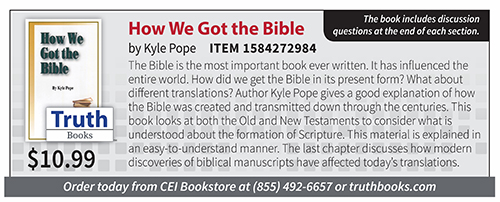

by Kyle Pope
Synopsis: What is the manuscript evidence for the Old Testament? How reliable is it, and how have modern discoveries affected what we know about the Hebrew Bible?
Over the last year, we have considered the steps God used to reveal and preserve His word in the Bibles that we can now read and follow so easily. As we end this study, we conclude with one final lesson, looking at the manuscripts used to translate the Old Testament.
We observed in earlier studies that the Old Testament was originally written in Hebrew, with a few passages in Aramaic (a Semitic language very similar to Hebrew). We also observed that, well before the New Testament, the Hebrew Old Testament was translated into the Greek version known as the Septuagint (LXX). In the early years, while some Christian converts from Judaism probably still read Hebrew, as time went on, more and more Christians read Greek—making the Septuagint the primary Old Testament used among Christians. As Latin became more common in the Roman Empire, eventually the Latin Vulgate translation became the primary Old Testament in the West, while the LXX remained dominant in the East. During these years, the scribes who continued to copy and preserve the Hebrew text were Jews. Even though most Jews did not believe Jesus was the Messiah, the Hebrew Old Testament continued as the Scriptures preserved and read in Jewish synagogues as it is to this very day.
There is no doubt that Jewish scribes respected the Scriptures as God's word. From the years AD 500-1000 in Tiberias, Babylon, and Jerusalem, Jewish scribes, known as the Masoretes, followed a strict massorah (or "tradition") of copying and preserving the Hebrew Old Testament. Part of this involved carefully counting every letter of a manuscript to preserve its accuracy. Out of fear that a damaged text might allow part of Scripture to be lost or misinterpreted, the Masoretes actually destroyed damaged manuscripts to avoid corruption. While this practice preserved the accuracy of the text, it also limited the number of surviving ancient manuscripts. Even so, these scribal practices preserved the text of the Hebrew Old Testament with amazing consistency. We call texts produced from this scribal process the Masoretic Text (MT). One of the most respected families of Masoretic scribes was that of Aaron ben Asher.
After the Middle Ages, when interest in looking back to the original texts of Scripture began to grow, scholars sought out the oldest surviving Old Testament manuscripts. Before the 1940s, there were two main manuscripts that represented the MT:
1. The Aleppo Codex. Named after the Syrian city where it stayed for centuries, this parchment codex was copied around AD 920 by Shlomo ben Buya'a and was verified by Aaron ben Asher. It was used by Maimonides, the famous Jewish physician, philosopher, and theologian. The Aleppo Codex was complete until 1947 when portions of it were lost in fires and riots. It is now in the Shrine of the Book in Jerusalem and can be viewed online at http://www.aleppocodex.org.
2. The Leningrad Codex. Named after the former Soviet name of St. Petersburg, Russia, where it has been for centuries, this parchment was copied in AD 1008 from manuscripts done by Aaron ben Asher. It is the oldest complete MT and has served as the basis for most editions of the Hebrew Old Testament. It is housed in the Imperial Library in St. Petersburg and may be read online at https://archive.org/details/Leningrad_Codex.
From the time the last book of the Old Testament was written until the Aleppo Codex was copied was about 1300 years. When compared to most other ancient manuscripts, such time gaps are not unusual. It was long believed that there would never be any manuscript evidence of the Old Testament found closer to the time it was originally penned. The twentieth century changed that assumption. Three important discoveries were made:
1. The Nash Papyrus. At the beginning of the century, four papyrus fragments of the Hebrew Old Testament were acquired by W. L. Nash and published in 1903. These dated to the second century BC and contained portions of the Ten Commandments.
2. The Dead Sea Scrolls. In 1946, a Bedouin named Muhammad ed-Dib threw a stone into a cave near the Dead Sea while looking for a goat that had wandered off. When he did, he heard the sound of breaking pottery. Inside the cave were found jars filled with manuscripts of religious and secular books stored away before the advance of the Roman armies upon Jerusalem in AD 70. Over the following decades, other caves were discovered with other manuscripts dating from 100 BC-AD 70. These scrolls were found to contain biblical manuscripts of almost the entire the Hebrew Bible. Most of these manuscripts are now in the Shrine of the Book in Jerusalem, and many can be viewed online at www.deadseascrolls.org.il.
When studied closely, it was found that the biblical texts matched the MT almost exactly. Where there were differences, the readings often matched wording reflected in the LXX and Vulgate, indicating the existence of a pre-Masoretic text-type that lay behind these ancient translations. What a remarkable affirmation this is—God's word has been preserved through the ages! How true are David's words, "The entirety of Your word is truth, and every one of Your righteous judgments endures forever" (Ps. 119:160).
With the Dead Sea Scrolls and the Nash Papyrus, the 1300-year time gap was reduced to only a few hundred years from the time the last Old Testament book was written. One final discovery reduced this gap even further…
3. The Silver Scroll Pendant. In 1979, near the Old City of Jerusalem, a tomb was excavated, and a small silver scroll necklace ornament was found with eighteen lines of Hebrew text dating to around 600 BC. The scroll contains a passage from Numbers 6:24-26: "The Lord bless you and keep you, the Lord make His face to shine upon you and give you peace." This represents the oldest biblical passage ever found. With this small discovery, the time gap was no longer a few hundred years—the scroll pendant was made before the Old Testament was completed!
So why should any of this matter to us? How does this relate to life in modern times? It matters because, in the pages of Scripture that have come down to us through the ages by the providence of God, the God of all creation has revealed Himself to us. Paul declared that the gospel is "the power of God to salvation" (Rom. 1:16). The Bible reveals this gospel. Peter declared that we may be "born again"— "through the word of God which lives and abides forever" (1 Pet. 1:23).
Life is short, and our time on earth is brief, but when we look to the words of the Bible, we are looking at something enduring. Peter wrote, "All flesh is as grass, and all the glory of man as the flower of the grass. The grass withers, and its flower falls away, but the word of the Lord endures forever" (1 Pet. 1:24-25a). Let us all look to this word, trust in it, and obey it with all our heart and soul. It is enduring, and it offers to us the only way to salvation.
Author-Bio: Kyle Pope preaches for the Olsen Park church of Christ in Amarillo, Texas. He has written several books published by Truth Publications including How We Got the Bible. The church website is olsenpark.com. He can be reached at kmpope@att.net.
